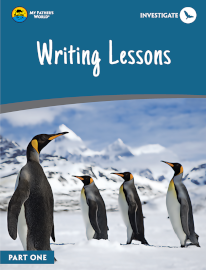The Writing Strands series, originally created by Dave Marks in the 1980s, was totally redesigned and rewritten in the Writing Strands series published by Master Books. While the original series took a secular approach, the Master Books series added a reading strand and strong Christian content throughout. The Master Books Writing Strand series will be great for some homeschoolers. Meanwhile, My Father’s World has been able to use the reorganized and edited content created by Master Books—without the Christian material or the reading strand—for their own series under the title Writing Lessons. This makes the Writing Lessons series much more like the original Writing Strands series than the Master Books Writing Strands series.
There are two books in the Writing Lessons series—Writing Lessons Part One and Writing Lessons Part Two, and they are recommended for grades five and six. Sixth graders new to Writing Lessons should begin with Part One.
The lessons are presented in units with two or three lessons per unit. The introduction in each book suggests that students complete two lessons per week, which means that each course should provide sufficient lessons for one school year.
Writing Lessons concentrates mainly on composition skills, teaching four primary strands of writing: creative, argumentative, report and research, and expository. Since the two books in the series are geared toward middle school students, they touch lightly on research and report writing, focusing more on narrative writing with lessons on description, organization, characters, dialog, point of view, etc. Students will do some writing directly in their books, but they will write many paragraphs and lengthier compositions in a notebook or elsewhere.
One page in each student book briefly describes the process for recording and studying spelling words, and this might be sufficient for covering spelling. While there are occasional lessons on grammar and usage, My Father’s World expects that you will use Writing Lessons along with the Language Lessons for Today book for fifth or sixth grade. Of course, you can always substitute another resource for covering grammar and other basic language arts skills.
Since the content is drawn from the original Writing Strands series, it shares the same casual and easy-to-understand tone that makes the books more inviting than most textbooks. The content is often presented with unique twists, making it interesting enough to motivate reluctant writers. Writing lessons are broken up into daily assignments to keep students from becoming overwhelmed.
Students will complete a Student Progress Report when they complete each writing assignment—a self-evaluation tool. A parent should go over these with students and help them note no more than a few problematic areas at a time. Either the parent or the student will write these down on a page titled “List of Problems to Solve,” found near the front of each book. During the course, parents should work with students to resolve these list items.
There are no teacher guides or answer keys since students are not answering predictable questions, and the essential information for composition instruction is included in each Writing Lessons book.
Summary
The Writing Lessons books do a great job of maintaining the engaging style of the original Writing Strands series while drawing on the great job that Master Books did of reorganizing and presenting the original books in a much easier-to-use format.








